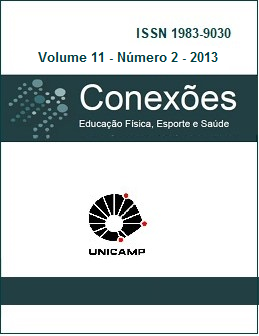Abstract
This study describes the process as did the teaching and learning ballroom dancing with a
person with hearing and visual disorders. For this purpose, we did a longitudinal analysis
of the classes performed between J. A. R., the teacher, male, 37 years old, and his student
W. L. W, female, 52 years old. The results show that the teacher developed and adapted
some technique to interact with your student; he used sign language on the left hand of
your pupil. Besides the communicative effectiveness of this technique, we observed that,
after school ballroom dance, the student has to present a better posture, physical agility,
more physical balance, and a significant improvement in self-confidence, which resulted in
a new communication strategy and more active social life for her. We conclude that the
teaching and the learning of the ballroom dancing, when based on knowledge that underlie
the bio-psycho-social of the human body, provides much more than technical and
(re)production steps. Allows overcoming physical, emotional and social, and can facilitate
the inclusion and personal fulfillment.
References
NIETZSCHE, F. Assim falou Zaratustra. São Paulo: Círculo do Livro, 1989
GUERVÓS, L. E. S. Nos limites da linguagem: Nietzsche e a expressão vital da dança. Cadernos Nietzsche, v. 14, p. 83-104, 2003.
FERREIRA, E. L. Corpo, movimento, deficiência: as formas dos discursos da/na dança em cadeira de rodas e seus processos de significação. Juiz de Fora: CBDCR. 2005a.
FERREIRA, E. L. O corpo do possível. In: FERREIRA E. L. (Org.). Dança artística e esportiva para pessoas com deficiência: multiplicidade, complexidade, maleabilidade corporal. Juiz de Fora: CBDCR. 2005b. v.1.
ORLANDI, E. Coreografar: inscrever significativamente o corpo no espaço. In: FERREIRA E. L.; FERREIRA M. B. R.; FORTI V. A. M. (Org.). Interfaces da dança para pessoas com deficiência. Campinas: Confederação Brasileira de Dança em Cadeira de Rodas, 2002, p. 89-95. v. 1.
CAZÉ, C. M. J.; OLIVEIRA, A. S. Dança além da visão: possibilidades do corpo cego. Pensar a Prática, Goiânia, v. 11, n. 3, p. 293-302, 2008. Disponível em: http://www.revistas.ufg.br/index.php/fef/article/view/3592/4263. Acesso em: 18 jun. 2012.
DANTAS, M. Dança: o enigma do movimento. Porto Alegre: Ed. da UFRGS, 1999.
PORTINARI, M. História da dança. 2. ed. Rio de Janeiro: Nova Fronteira. 1989.
SOUZA, N. C. P.; CARAMASCHI, S. Contato corporal entre adolescentes através da dança de salão na escola. Motriz, Rio Claro, v. 17, n. 4, p. 618-629, out./dez. 2011.
RODRIGUES, G. M. Em cena, olhares para a travessia de corpos que dançam. Conexões: educação física, esporte, lazer, Campinas, v. 6, p. 47-50, dez. 2011.
The Conexões: Educação Física, Esporte e Saúde Journal uses the license of Creative Commons (CC), thus preserving the integrity of articles in an open access environment.

